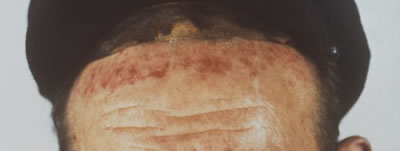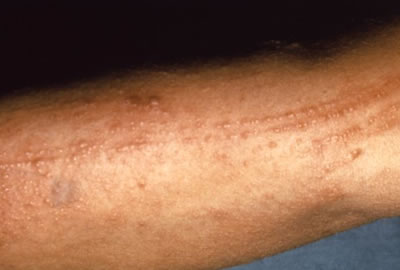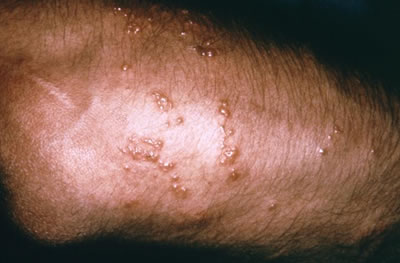Contact Dermatitis
Contact dermatitis is an inflammation of the
skin as result of it touching something. There are two forms of
contact dermatitis:
- Irritant contact dermatitis
A common condition where an irritant, usually chemical in nature,
touches the skin. An example is hand eczema,
where the skin of the hand develops red and rough rashes after
touching soaps, solvents, and dishwashing detergents.

Contact dermatitis due to irritant found
in hat liner.
- Allergic contact dermatitis
An allergic reaction to various allergens, such as:
- Plant allergens (poison ivy, sumac, oak)
- The metal nickel (found in jewelry)
- Fragrances
- Preservatives and additives
- Chemicals used in manufacturing

Lesions due to contact with poison oak

Blister due to contact with poison ivy
To determine the specific allergens that cause the allergic
reaction, a patch test is usually performed.
Here, about 30 to 50 different allergens are placed on the skin
of your back for 2 days.
Note that patch testing is different from prick testing done
for identifying breathing allergies.
Symptoms of Contact Dermatitis
The symptoms of contact dermatitis include:
- Red blisters
- Flaking and oozing of the skin
- Sever itching
Prevention of Contact Dermatitis
The easiest way to prevent contact dermatitis is to avoid touching
the allergens in the first place:
- Avoid poison ivy, sumac, and oak plants, as oils from these
plants are potent allergens
- If you come in contact with these plants, quickly wash the
skin with warm water. Then wash it again with soap and water.
- Wear pants and long-sleeved shirts
- Use barrier lotions on exposed skins
- Thoroughly wash clothes, tools, and shoes after going outdoors
- Wash pets thoroughly if they potentially come in contact with
these plants
- Avoid burning firewood that may come in contact with poison
ivy, as this may produce smoke with airborne allergens.
Contact Dermatitis Treatment
Treatment for contact dermatitis include:
- Compress to dry the blisters
- Topical corticosteroid prescription
- Oral corticosteroid medications


